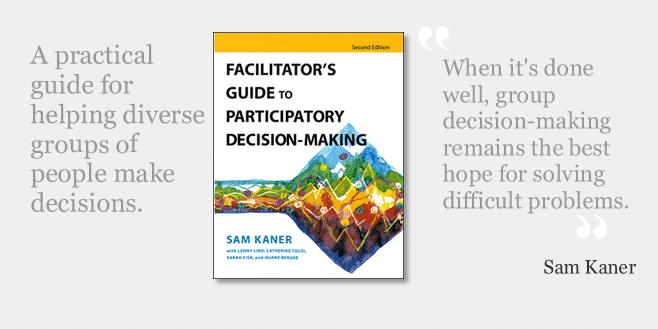Review Overview
Interesting content - 8
Easy to read - 10
Usefulness - 10
9.3
A great book if you have any group of people who need to make a decision.
Everyone likes to have a “participatory” project. Donors like it because it makes them sound like they’re supporting locally led development; international NGOs like it because it makes them feel better about being outsiders; and local NGOs like it because the more participatory a project is the more donors want to fund it.
The problem that many people don’t realise (or don’t care about) is that a “participatory” project means more than just having people participate. It actually means that local community members and stakeholders are involved in making decisions about the project – even if that means not running the project, or changing it completely from the original plan.
Unfortunately, all this participation can be messy and inconvenient for the NGO and donor. So in reality it often doesn’t happen (the NGO director makes all the decisions), or community members and stakeholders are invited to a serious of boring workshops where they undergo facipulation by project staff.
Facipulation: a delicate blend of facilitation (catalyzing, easing and supporting conversations and actions around themes and issues important to the community and/or program participants) and manipulation (steering conversations towards their INGO’s established themes and goals, and ensuring that actions and decisions made by local people support their INGO’s interests and happen within the time frame stipulated by their donors).
Shotgun Shack, Stuff Expat Aid Workers Like
The Facilitator’s Guide to Participatory Decision-Making by Sam Kaner is an instruction manual for avoiding this scenario. Through it’s big, friendly diagrams and easy-to-follow text, Kaner’s book explains how groups of very different people actually make decisions (as opposed to how we wish they did). The guide is written for someone who is trying to help a group of people make a decision so that all the people in the group actually own the decision at the end.
The author starts by explaining how groups often start a discussion with divergent thinking, where people creatively brainstorm different ideas. This quickly leads to the groan zone, where there are many opposing ideas, misunderstandings, and disagreements. The author doesn’t shy away from the truth of group decision making – they believe that “working through these misunderstandings is part of what must be done to lay the foundation for sustainable agreements”. The final section of the book explains how groups can move past the groan zone into convergent thinking, where the list of possible options gets narrowed down so that the group finally makes a decision.
One of my favourite things about this book is that it is presented as a series of stand-alone pages that the facilitator can photocopy for the group. There are pages that explain the do’s and don’ts of brainstorming, how to write flipcharts clearly, and activities to help the group make a final choice. You can either read the pages from start to finish following all the steps in the process, or you can just flip through the book looking for useful tips. It isn’t written specifically for international development practitioners, although it is written for any group with diverse backgrounds, so all the advice is still relevant.
This book is great if you have a group of people who need to make a decision. Group decision making often happens during program design and strategic planning, where program staff, stakeholders and hopefully participants decide on the organisation’s future direction. It can also happen during evaluation at the end of the project when the evaluator, program staff, donor, participants and/or stakeholders need to decide whether the project was effective or not. This book won’t replace all the years of experience required to become a top-notch facilitator, but if you don’t have an experienced facilitator handy it will give you a very good start.




